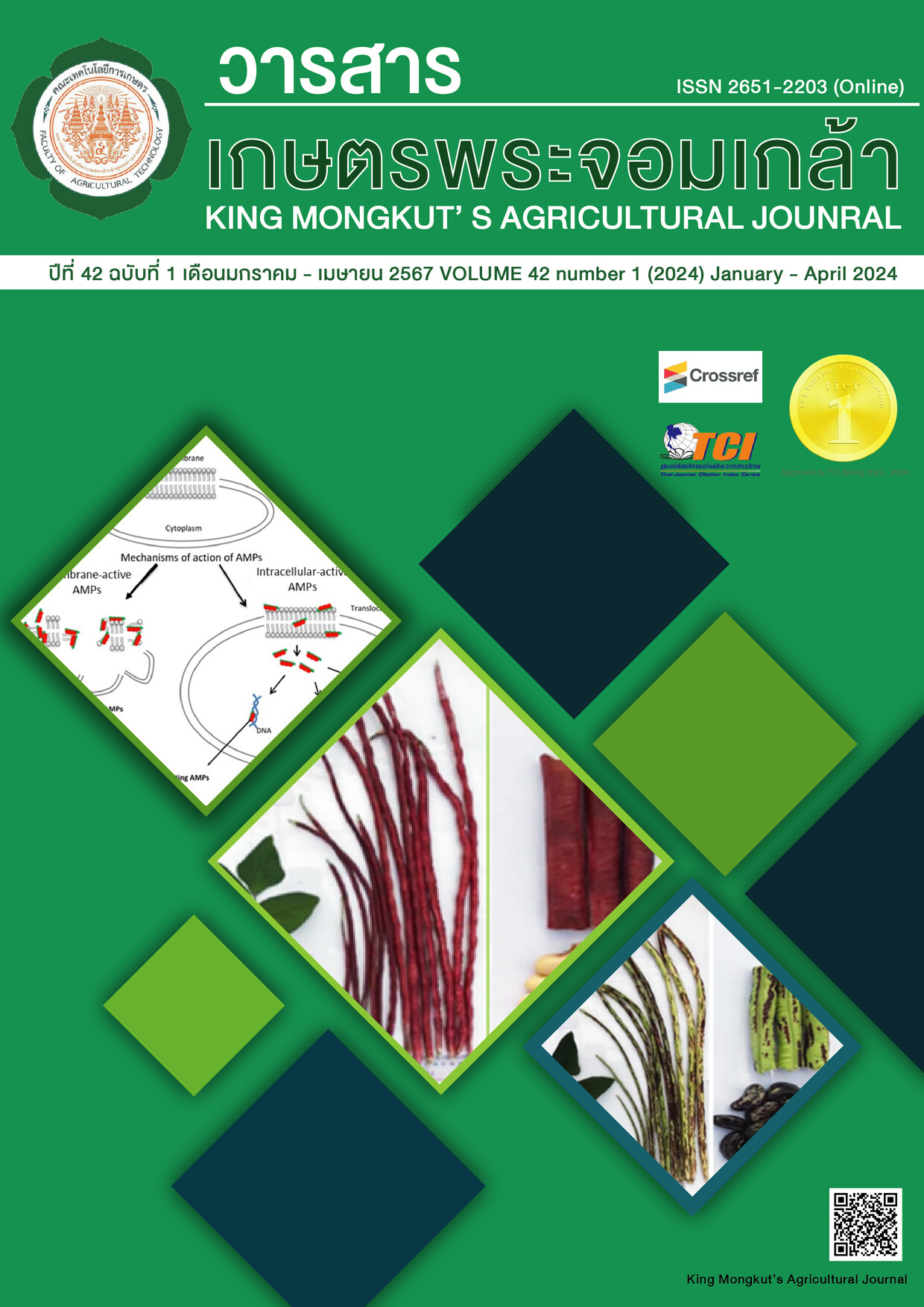การบำบัดน้ำเสียที่มีสีย้อมโรดามีน บี ปนเปื้อนโดยใช้สาหร่าย Spirulina platensis ที่ตรึงในอัลจิเนต
Main Article Content
บทคัดย่อ
การบำบัดน้ำเสียที่มีสีย้อมโรดามีน บี ปนเปื้อนโดยใช้สาหร่าย Spirulina platensis ที่ตรึงในอัลจิเนต โดยศึกษาปัจจัยที่เหมาะสมต่อการดูดซับสีย้อม ได้แก่ พีเอช ระยะเวลา ปริมาณตัวดูดซับ และความเข้มข้นของสีย้อมเริ่มต้น พบว่าค่าพีเอชที่เหมาะสมต่อการดูดซับสีย้อมคือพีเอช 2 โดยดูดซับได้ 0.86±0.00 มิลลิกรัมต่อกรัม การดูดซับเกิดอย่างรวดเร็วและถึงจุดสมดุลที่ 180 นาที โดยมีค่าการดูดซับ 1.24±0.00 มิลลิกรัมต่อกรัม ปริมาณตัวดูดซับ ที่เพิ่มขึ้นมีผลทำให้ค่าการดูดซับของสาหร่ายลดลง ส่วนการเพิ่มความเข้มข้นเริ่มต้นของสีย้อมส่งผลให้ค่าการดูดซับ ของสาหร่ายเพิ่มขึ้น การศึกษาไอโซเทอร์มการดูดซับของสีย้อมพบว่าสอดคล้องกับไอโซเทอร์มการดูดซับของแลงเมียร์ โดยมีค่าการดูดซับสูงสุด (qm) เท่ากับ 52.70±3.18 มิลลิกรัมต่อกรัม การศึกษาจลนพลศาสตร์การดูดซับสอดคล้องกับปฏิกิริยาอันดับสองเสมือน และมีขั้นกำหนดอัตราเร็วของการดูดซับคือการแพร่ผ่านชั้นฟิล์มและการแพร่เข้าภายในเซลล์ขั้นสอง จากผลการศึกษาแสดงให้ทราบว่าสาหร่าย S. platensis ที่ตรึงเซลล์ในอัลจิเนตสามารถประยุกต์ใช้ใน การบำบัดน้ำเสียที่มีสีย้อมโรดามีน บี ปนเปื้อนได้
Article Details

อนุญาตภายใต้เงื่อนไข Creative Commons Attribution-NonCommercial-NoDerivatives 4.0 International License.
วารสารเกษตรพระจอมเกล้า
เอกสารอ้างอิง
Agrawal, G. L. (1990). Basic Chemical Kinetics. Tata McGraw-Hill Publishing Company Limited.
Al Hamadi, A., Uraz, G., Katircioglu, H., & Osmanağaoğlu, Ö. (2017). Adsorption of azo dyes from textile wastewater by Spirulina platensis. Eurasian Journal of Environmental Research, 1(1), 19-27.
Cardoso, N. F., Lima, E. C., Royer, B., Bach, M. V., Dotto, G. L., Pinto, L. A. A., & Calvete, T. (2012). Comparison of Spirulina platensis microalgae and commercial activated carbon as adsorbents for the removal of Reactive Red 120 dye from aqueous effluents. Journal of Hazardous Materials, 241-242, 146–153.
Da Rosa, A. L. D., Carissimi, E., Dotto, G. L., Sander, H., & Feris, L. A. (2018). Biosorption of rhodamine B dye from dyeing stones effluents using the green microalgae Chlorella pyrenoidosa. Journal of Cleaner Production, 198, 1302–1310.
Deniz, F., & Kepekci, R. A. (2015). Bioremediation of contaminated water with unnatural dye using blue-green alga Spirulina platensis. Environmental Progress & Sustainable Energy, 34(5), 1414-1419.
Duarte Neto, J. F., Pereira, I. D. S., da Silva, V. C., Ferreira, H. C., Neves, G. de A., & Menezes, R. R. (2018). Study of equilibrium and kinetic adsorption of rhodamine B onto purified bentonite clays. Cerâmica, 64, 598-607.
El-Sheekh, M. M., Gharieb, M. M., & Abou-El-Souod, G. W. (2009). Biodegradation of dyes by some green algae and cyanobacteria. International Biodeterioration & Biodegradation, 63(6), 699-704.
Gad, H. M. H. & El-Sayed, A. A. (2009). Activated carbon from agricultural by-products for the removal of Rhodamine-B from aqueous solution. Journal of Hazardous Materials, 168(2-3), 1070–1081.
Gunasundari, E., Senthil Kumar, P., Rajamohan, N., & Vellaichamy P. (2020). Feasibility of naphthol green-B dye adsorption using microalgae: thermodynamic and kinetic analysis. Desalination and Water Treatment, 192, 358–370.
Hii, S. L., Yong, S. Y. & Wong, C. L. (2009). Removal of rhodamine B from aqueous solution by sorption on Turbinaria conoides (Phaeophyta). Journal of Applied Phycology. 21(5), 625–631.
Kankılıç, G. B. (2022). Scenedesmus regularis: An alternative biosorbent for the efficient and fast removal of methylene blue. Global NEST Journal. 24(3), 465-473.
Kaushal M., & Tiwari, A. (2010). Removal of rhodamine-B from aqueous solution by adsorption onto crosslinked alginate beads. Journal of Dispersion Science and Technology. 31(4), 438–441.
Li, H., Jin, R., Hu, H., Kalkhajeh, Y. K., Zhao, Y., Gao, Y., & Zhang, B. (2021). Adsorption of As(III), Pb(II), and Zn(II) from Wastewater by Sodium Alginate Modified Materials. Journal of Analytical Methods in Chemistry, 2021, 11.
Mahdieh, M., Zolanvari, A., Azimee, A. S., & Mahdieh, M. (2012). Green biosynthesis of silver nanoparticles by Spirulina platensis. Scientria Iranica, 19(3), 926-929.
Nicoletti, M. (2016). Microalgae nutraceuticals. Foods, 5(3), 54–62.
Nithya, K., Sathish, A., Pradeep, K., & Baalaji, S. K. (2019). Algal biomass waste residues of Spirulina platensis for chromium adsorption and modeling studies. Journal of Environmental Chemical Engineering, 7(5). http://doi.org/10.1016/j.jece.2019.103273.
Ruangsomboon, S. (2006). Biosorption of Heavy Metal from Wastewater by Algae. King Mongkut’s Institute of Technology Ladkrabang. (in Thai).
Ruangsomboon, S., Kitprasoet S., Chongphat B., & Deemak J. (2019). Innovative cultivation of Spirulina supplemented with flue gas from feed mill and powerplant. In The 9th National Conference on Algae and Plankton, pp. 93-100. Kasetsart University. (in Thai).
Saadi, R., Saadi, Z., Fazaeli, R., & Fard, N. E. (2015). Monolayer and multilayer adsorption isotherm models for sorption from aqueous media. Korean Institute of Chemical Engineers, 32(5), 787-799.
Salleh, M. A. M., Mahmoud, D. K., Karim, W. A. W. A., & Idris, A. (2011). Cationic and anionic dye adsorption by agricultural solid wastes: A comprehensive review. Desalination, 280(1-3), 1–13.
Saloglu, D. & Sahin, O. I. (2021). Removal of azo dyes – tartrazine, carmoisine, and allura red–from wastewater using Spirulina biomass-immobilized alginate beads: equilibrium, kinetics, thermodynamics, desorption, and reusability. Desalination and Water Treatment, 220, 431–445.
Volesky, B., & Holan, Z. R. (1995). Biosorption of heavy metals. Biotechnology Progress, 11, 235-250.
Wan Ngah, W. S., Teong, L. C., & Hanafiah, M. A. K. M. (2011). Adsorption of dyes and heavy metal ions by chitosan composites: A review. Carbohydrate Polymers, 83(4), 1446–1456.


